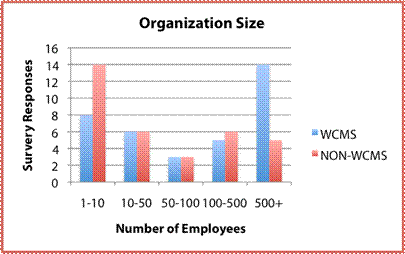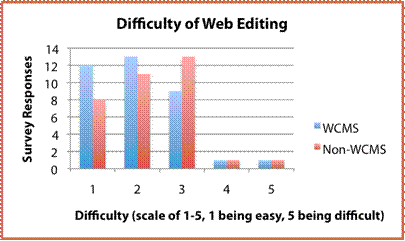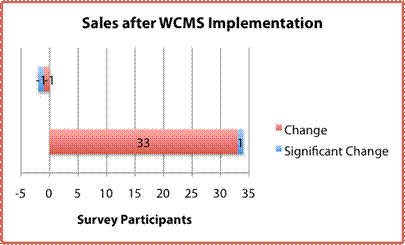"The Benefits of Using Web Content Management Systems"
Gregory L. Koch IIGregory L. Koch II earned his Bachelor’s degree in Technical Communication from New Mexico Tech in May of 2009 and is currently pursuing a Master’s degree in Information Technology at Rochester Institute of Technology. His interests include visual design, Internet and web communications, and single sourcing, server and network management. Greg has developed several web applications using Web Content Management Systems and recently served as Lead Web Developer and Designer for New Mexico Tech’s website redesign project.
Contents |
Results and DiscussionI received a total of 71 responses. I deleted one response because it was incomplete. The total number of evaluated responses was 70. Of these 70 responses, 36 people (51.4%) stated they were using Web Content Management Systems (WCMSs) and 34 people (48.6%) stated they were not. The data supports my theory that WCMSs are becoming more used, but they are still not a standard across the industry. The results of each question can be found in Appendix B. All ParticipantsI began the survey by asking participants about their role in their organizations. I have broken this data into two categories: users of WCMSs, and non-users. The data, shown in Table 1, reveal that most participants were considered either content developers or Webmasters (encompassing all positions: content developer, designer, and programmer). The data also show that more WCMS users are classified as Webmaster than those not using a WCMS. The data illustrates that by implementing a WCMS, organizations are able to combine the tasks of the typical web team (developing content, designing pages, programming pages) and create all-inclusive positions, allowing all members of the team to work on the same type of work. Table 1: Positions Held by Survey Participants
The next question asked participants how many people their organization employs. Table 2 shows the size of the organization and the need for a WCMS. The organizations that use WCMSs clearly have more employees. Table 2: Organization Size Based n Number of Employees
Figure 1 illustrates that WCMS users and non-WCMS users are near opposites in organization sizes.

Figure 1 : Organization Size Based on Number of Employees As an extension to the previous question, I asked how many employees were specifically responsible for web content within the organization. The results of this question are somewhat proportionate to the previous, and show that smaller organizations are not using WCMSs. Table 3: Organization Size
 Figure 2: Number of Employees Responsible for Web Content I was expecting to see a very large difference in the time it took WCMS users to enter pre-created content into their website versus non-WCMS users. I was surprised to see that the time required to insert content was similar for both. These numbers did not seem to have any kind of correlation to the size of the organization or number of employees working on the website either. Table 4: Time Required to Insert Content into Website
The last question asked all participants to rate how difficult they felt it was to upload pre-created content to their website. Participants using a WCMS rated the difficultly slightly lower than those not using a WCMS, as shown in Table 5. Table 5 : Difficulty of Web Editing
Even though the results were similar, in Figure 3 it is clear that WCMS users find editing their website a bit easier than those not using a WCMS.
 Figure 3 : Difficulty of Web Editing The data collected from the participants’ answers demonstrate that by using a WCMS, a business can save a significant amount of time, hire fewer employees to complete web content tasks, and make managing websites much easier. As shown in Figure 1, WCMSs are more common in larger businesses but can benefit small business if the WCMS is used properly. Participants Using Web Content Management SystemThe first question that was asked to only WCMS users identified how long they have been using their WCMS. A large amount of participants indicated they have only been using a WCMS between one and three years. This data argue that WCMSs are becoming more used, but are still not an industry standard. Table 6: Duration a WCMS Has Been Used in the Organization
The results of this question were surprising: 91.6% of the participants that are using a WCMS reported an increase in sales and web referrals. This figure demonstrates a significant trend, and shows the potential and benefits of a WCMS. The use of a WCMS has clearly created an advantage for these organizations, helping them increase their profits. As shown in Figure 4, thirty-three participants reported an increase in sales, one reported a significant increase, one reported a decrease, and one reported a significant decrease.
Figure 4 : Sales after WCMS Implementation Looking at this data further, the participant that reported a significant increase had been using a WCMS for more than five years. By contrast, the participant that reported a decrease had only been using a WCMS for one to three years, and the participant that reported a significant decrease had been using a WCMS for less than one year. Of the 33 participants who showed an increase in sales and web referrals, the duration they had been using a WCMS varied significantly. Though the data varied, they show that it is possible to benefit from using a WCMS within the first year of installation, and the benefits increase as time progresses. Table 7: Duration of WCMS use With Increased Sales
I asked participants if the costs of maintaining their website had increased or decreased since they began using a WCMS. The data, shown in Table 8, were scattered and did not prove one way or the other that the WCMS itself was a cause of increased or decreased costs. The licensing systems used by WCMS companies varied and could not be ruled out as cost factors and the reason for an increase or decrease in costs. Increased costs can easily be offset by an increase in sales, and 91.6% of the participants indicated an increase in sales, as shown in Figure 4. Table 8 : Costs of Maintenance after WCMS Implementation
After reviewing the previous data, and seeing such wide variety of data, I was expecting to see some correlation between the sales, costs, and sizes of companies with the type of licensing used when implementing a WCMS. Oddly enough, the licensing was split evenly three ways, as seen in Figure 5.
[image248::]
Figure 5 : WCMS Licensing Used Since most participants stated they experienced sales increases, there were no direct correlations between the licensing method and sales increases. The participant who had significant sales increases and also the participant who had significant decreases had been using open source systems. The participant who had (non-significant) sales decreases had been using a proprietary system. Of the other 33 participants using a WCMS, ten had been using open source systems, 12 had been using licensed systems, and 11 had been using proprietary systems. Participants Not Using Web Content Management SystemAbout half of the participants indicated they were not using WCMSs. Of the thirty-four participants, twenty-three said they are using a WYSIWYG editor like Dreamweaver or FrontPage. These applications present the user with an easy point-and-click method of editing files, but do not provide intuitive methods of including CSS files, which users generally embed into each individual HTML file. Applications like FrontPage require the user to specify server settings to upload files. Because of this requirement, the user needs knowledge of technologies like FTP. Only three of the thirty-four participants indicated they are using offline WCMSs like Contribute. Software like Contribute works just like Dreamweaver with a WYSIWYG editor, requiring settings to be entered, but adds support for multiple users and simultaneous editing. In addition to using WYSIWYG editors, 25 of the 34 participants indicated they also manually edit HTML files. This shows that users who do not use WCMSs are required to have knowledge of programming languages. These same users also indicated that editing their website is more difficult and that adding content to their website takes slightly longer versus those using a WCMS for the same tasks. |
